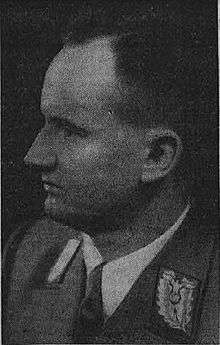Friedrich Rainer
| Friedrich Rainer | |
|---|---|
 | |
| Governor of Salzburg | |
|
In office 22 May 1938 – 29 November 1941 | |
| Preceded by | Anton Wintersteiger |
| Succeeded by | Gustav Adolf Scheel |
| Governor of Carinthia | |
|
In office 1 December 1941 – 7 May 1945 | |
| Preceded by | Wladimir von Pawlowski |
| Succeeded by | Hans Piesch |
| Personal details | |
| Born |
28 July 1903 Sankt Veit an der Glan, Carinthia, Austria-Hungary |
| Died |
19 July 1947 (aged 43) Ljubljana, Yugoslavia |
| Political party | NSDAP |
| Profession | Notary |
Friedrich W. Rainer (28 July 1903 – 19 July 1947) was an Austrian Nazi politician, Gauleiter as well as a state governor of Salzburg and Carinthia. He is the only Austrian governor who has ever held the same office in two separate states.
Personal background
Rainer was a native of Sankt Veit an der Glan in Carinthia, the son of a German nationalist vocational teacher at a municipal Bürgerschule (secondary school). He attended the Realgymnasium in Klagenfurt and, having obtained his Matura degree, studied law at the University of Graz while he earned his living by working in a local banking institution or in general labor. After successfully completing his law examination, Rainer began working in a notary's office and completed his doctorate in 1926. From 1931 he worked as a notary public in Klagenfurt.
Political involvement
Since Rainer was a student in high-school, he engaged as a member of right-wing organizations in Sankt Veit and also participated in the armed Austro-Slovene conflict in Carinthia. Prior to his graduation from law school in Graz, he joined the Austrian SA in 1923 and joined a Burschenschaft student fraternity.
In October 1930, Rainer joined the Nazi Party establishing the local branch in Sankt Veit. A close friend of Odilo Globocnik, he joined the SS in 1934 and also the Sicherheitsdienst (SD) intelligence agency. In the same year he took up a post at the office of Nazi Gauleiter Hubert Klausner in Klagenfurt. As the Nazi Party had been banned by the Austrian government under Chancellor Engelbert Dollfuss in 1933, Rainer was in August 1935 sentenced to one year in police custody, presumably for high treason. He was released early for good behaviour the following March, nevertheless like Klausner and his deputy Globocnik he had to step down from his administrative role in the party, transferring sole leadership to the rival Austrian Nazi leader Josef Leopold. As Leopold soon fell out of favour with Adolf Hitler, Friedrich was in May 1936 again assigned to the Nazi Party's provincial body in Carinthia.
Governor
In the course of the Austrian Anschluss to Nazi Germany on 13 March 1938, Rainer was recruited to serve as the organizational staff leader in the office of Josef Bürckel, the Reichskommissar responsible for the annexation of the Austrian lands. On 22 May 1938, Rainer was personally appointed by Hitler to oversee the Nazi Party in the Reichsgau of Salzburg. Upon the 1938 elections, he also was appointed member of the Reichstag legislature in Berlin. Rainer remained in his Gauleiter role at Salzburg, until 18 November 1941, when he was succeeded by Gustav Adolf Scheel.
When World War II broke out, Rainer was appointed as Reich Defence Commissar of the military district XVIII. On 15 March 1940, he was additionally appointed as the Reichsstatthalter (Reich Governor) of Salzburg. On 18 November 1941, Rainer was appointed as the Party's Gauleiter of Carinthia, while simultaneously functioning in the role of a governor, thereby also ruling over the adjacent occupied Yugoslavian territories in Upper Carniola. On 11 December 1942, Rainer was made Reich Defence Commissar of Carinthia, much like his role in Salzburg. After Italy abandoned its German ally on 8 September 1943, Rainer took over the Operational Zone of the Adriatic Littoral as High Commissioner in the rank of a SS–Obergruppenführer. This act established him as the chief of the civil administration in the Italian region of Friuli, as well as in Yugoslavian Istria and Inner Carniola.
Sentencing and death
On 7 May 1945, eight days after Hitler's suicide, Rainer transferred his official functions to an executive board and fled to the mountainous area around the Weißensee lake in Carinthia. After being given leads by the local population, British occupation troops arrested Rainer and transferred him to Nuremberg, where he was compelled to testify in the Nuremberg Trials against the 24 main defendants, specifically in the case against the former Austrian chancellor Arthur Seyss-Inquart.
On 13 March 1947, Friedrich was extradited to Yugoslavia. On 10 July 1947, he was brought before a military court of the Yugoslav 4th Army at Ljubljana. He was found guilty of crimes against the people and sentenced to death on 19 July 1947. His widow received a death certificate from Yugoslavia after the war, which showed that same date. Nevertheless, as in similar cases, rumours lingered on into the 1950s that Rainer was still alive, working for the Yugoslav Department of State Security.
Published works
- Rainer, Friedrich. On Brecht and Eisenstein, New York: Telos Press, issue 31, 1977.
- Rainer, Friedrich. My Internment and Testimony at the Nuremberg War Crimes Trial, Edwin Mellen Press Ltd; illustrated edition, 2006. ISBN 978-0-7734-5665-5
External links
| Wikimedia Commons has media related to Friedrich Rainer. |
- Friedrich Rainer and Odilo Globocnik at Holocaust Education Archive & Reserarch Team (H.E.A.R.T)
